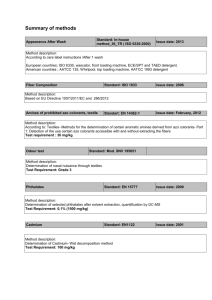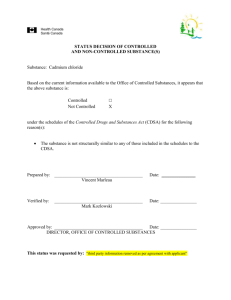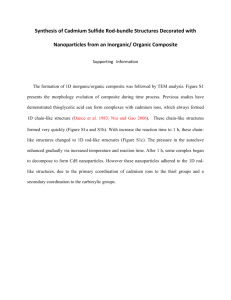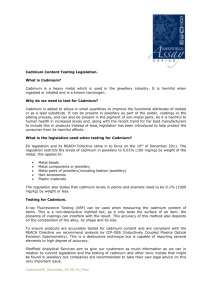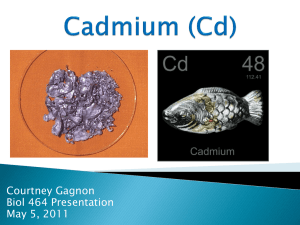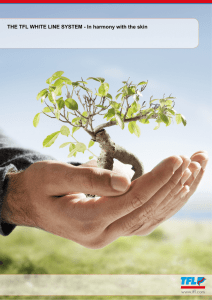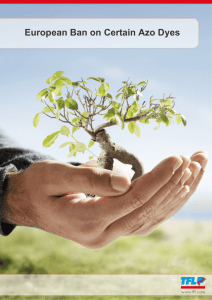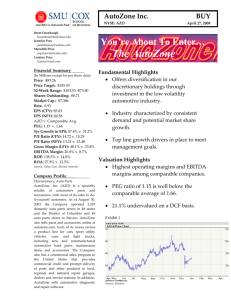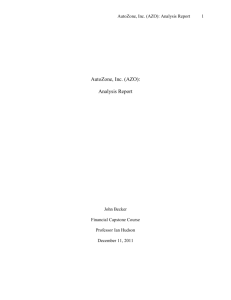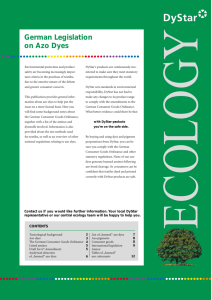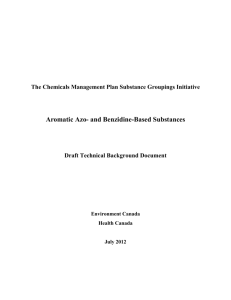Legal and regulatory framework
advertisement
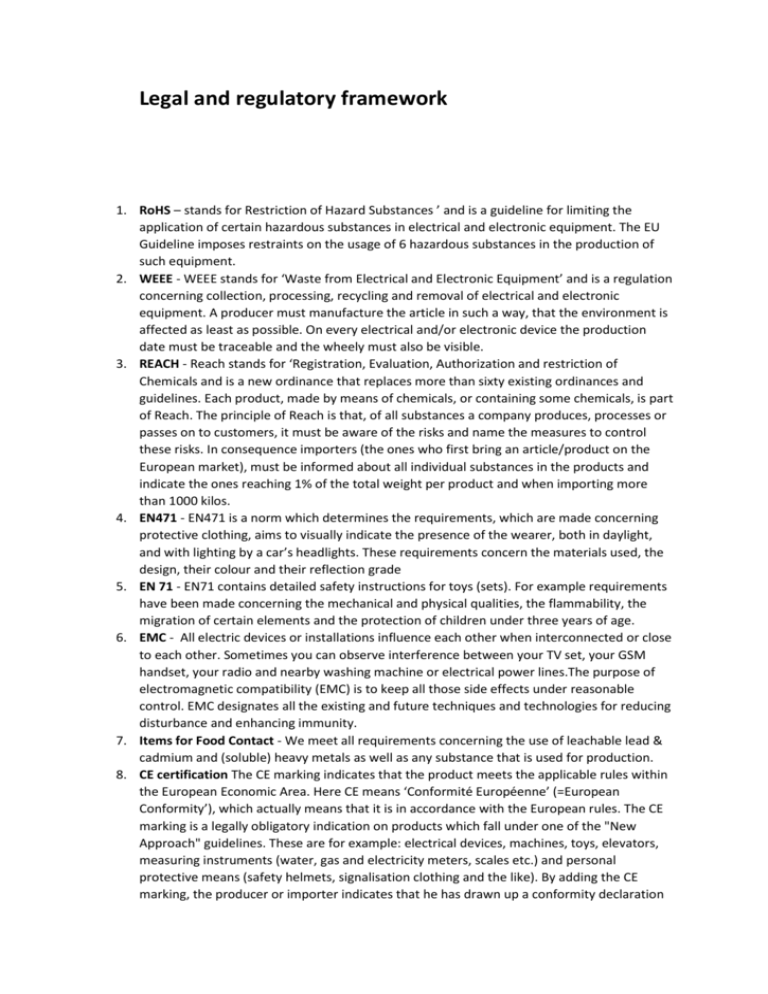
Legal and regulatory framework 1. RoHS – stands for Restriction of Hazard Substances ’ and is a guideline for limiting the application of certain hazardous substances in electrical and electronic equipment. The EU Guideline imposes restraints on the usage of 6 hazardous substances in the production of such equipment. 2. WEEE - WEEE stands for ‘Waste from Electrical and Electronic Equipment’ and is a regulation concerning collection, processing, recycling and removal of electrical and electronic equipment. A producer must manufacture the article in such a way, that the environment is affected as least as possible. On every electrical and/or electronic device the production date must be traceable and the wheely must also be visible. 3. REACH - Reach stands for ‘Registration, Evaluation, Authorization and restriction of Chemicals and is a new ordinance that replaces more than sixty existing ordinances and guidelines. Each product, made by means of chemicals, or containing some chemicals, is part of Reach. The principle of Reach is that, of all substances a company produces, processes or passes on to customers, it must be aware of the risks and name the measures to control these risks. In consequence importers (the ones who first bring an article/product on the European market), must be informed about all individual substances in the products and indicate the ones reaching 1% of the total weight per product and when importing more than 1000 kilos. 4. EN471 - EN471 is a norm which determines the requirements, which are made concerning protective clothing, aims to visually indicate the presence of the wearer, both in daylight, and with lighting by a car’s headlights. These requirements concern the materials used, the design, their colour and their reflection grade 5. EN 71 - EN71 contains detailed safety instructions for toys (sets). For example requirements have been made concerning the mechanical and physical qualities, the flammability, the migration of certain elements and the protection of children under three years of age. 6. EMC - All electric devices or installations influence each other when interconnected or close to each other. Sometimes you can observe interference between your TV set, your GSM handset, your radio and nearby washing machine or electrical power lines.The purpose of electromagnetic compatibility (EMC) is to keep all those side effects under reasonable control. EMC designates all the existing and future techniques and technologies for reducing disturbance and enhancing immunity. 7. Items for Food Contact - We meet all requirements concerning the use of leachable lead & cadmium and (soluble) heavy metals as well as any substance that is used for production. 8. CE certification The CE marking indicates that the product meets the applicable rules within the European Economic Area. Here CE means ‘Conformité Européenne’ (=European Conformity’), which actually means that it is in accordance with the European rules. The CE marking is a legally obligatory indication on products which fall under one of the "New Approach" guidelines. These are for example: electrical devices, machines, toys, elevators, measuring instruments (water, gas and electricity meters, scales etc.) and personal protective means (safety helmets, signalisation clothing and the like). By adding the CE marking, the producer or importer indicates that he has drawn up a conformity declaration for the product concerned. In this conformity declaration the producer or importer is compelled to indicate that the product meets all applicable European guidelines. Besides, the producer or importer commits himself to being liable for his product. Substances 9. Phthalates - substances used as plasticizers (substances added to plastics to increase their flexibility, transparency, durability, and longevity). They are used primarily to soften polyvinyl chloride. Phthalates are being phased out of many products in the United States, Canada, and European Union over health concerns. Phthalates Limit: DINP, DIDP & DNOP 0.1% by mass of plasticized material Phthalates Limit: DEHP, DBP and BBP 0.1% by mass of plasticized material 10. Cadmium - Cadmium is a metal which is primarily mined as by-product from zinc ore. Just like lead and zinc, it belongs to the group heavy metals, which in small quantities can be harmful to the environment and people’s health. The Cadmium decree 1999 forbids the use of cadmium as pigment, dye, stabiliser and surface layer. Furthermore, the decree forbids the production, import, trading and keeping stock of among other things products, in which pigment, dye or stabiliser has been used, and of which the cadmium content is higher than 100 milligrams per kilo, and of products with a cadmium containing surface layer, in which a substance or paint has been used with a cadmium content of more than 100 milligrams per kilo. Cadmium Limit: Surface coating and plastic components shall have total cadmium content no more than 100 mg/kg (ppm) 11. Nickel - The metal is corrosion-resistant, finding many uses in alloys, as a plating, in the manufacture of coins, magnets and common household utensils, as a catalyst for hydrogenation, and in a variety of other applications. Nickel (skin contact) Shall not exceed 0.2 micrograms/cm2 per week 12. Formaldehyde - Formaldehyde is a naturally occurring substance in the environment made of carbon, hydrogen and oxygen. Natural processes in the upper atmosphere may contribute up to 90 percent of the total formaldehyde in the environment. Formaldehyde is an intermediate in the oxidation (or combustion) of methane as well as other carbon compounds, e.g. forest fires, in automobile exhaust, and in tobacco smoke. When produced in the atmosphere by the action of sunlight and oxygen on atmospheric methane and other hydrocarbons, it becomes part of smog. Formaldehyde has also been detected in outer space. Formaldehyde (textiles) Limit: < 36 months : 20ppm Limit: > 36 months : 75ppm Limit: releasable formaldehyde < 250ppm 13. Pentachlorophenol - In the past, PCP has been used as a herbicide, insecticide, fungicide, algaecide, disinfectant and as an ingredient in antifouling paint. Some applications were in agricultural seeds (for nonfood uses), leather, masonry, wood preservation, cooling tower water, rope and paper mill system. Its use has been significantly declined due to the high toxicity of PCP and its slow biodegradation. There are two general methods for preserving wood. The pressure process method involves placing wood in a pressure-treating vessel where it is immersed in PCP and then subjected to applied pressure. In the non-pressure process method, PCP is applied by spraying, brushing, dipping, and soaking. Pentachlorophenol (PCP) Limit: 5ppm in wooden items 14. Nonylphenol - The material known collectively as nonylphenol is produced by acid-catalyzed alkylation of phenol with a mixture of nonenes. Alkylphenols are subjected to ethoxylation to give alkylphenol ethoxylates (APEs), which are widely used as industrial surfactants. They are used in the processing of wool and metals, as emulsifiers for emulsion polymerization, as laboratory detergents, and as pesticides. APEs are a component of some household detergents outside of Europe. In Europe, due to environmental concerns, they have been replaced by more expensive alcohol ethoxylates, which are less problematic environmentally. Nonylphenol (NP) Limit for textiles: Less than 0.1% 15. Azo dyes - Azo are dyes, which through direct contact with the skin, can be harmful to general health. Therefore, in the ‘Warenwetbesluit Azo kleurstoffen 1998’ (~’Commodities Act Azo dyes 1998’), it has been stipulated, that it is forbidden to process Azo dyes in textile and leather products, unless they are present as pigment. Azo Colourants Fabrics & leather are prohibited from using azo dyes, which are capable of decomposing into one or more aromatic amines, which have levels in excess of 30ppm.
